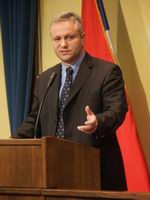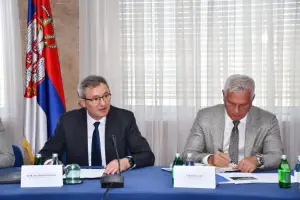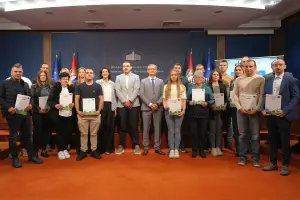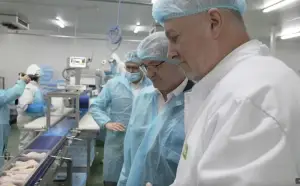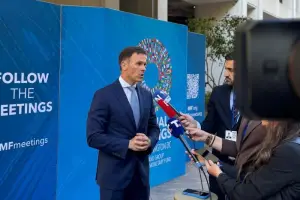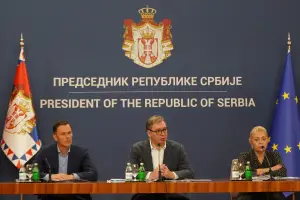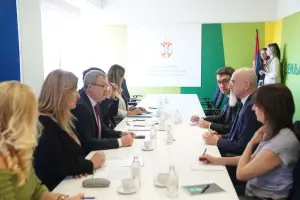Q:
A:
Budget sees 1.73 billion dinar surplus in August
Belgrade,
6 September 2004
Serbian Minister of Finance Mladjan Dinkic said today that Serbia’s budget has recorded a 1.73 billion dinar surplus in August, for the first time this year, which signaled the establishing of full macroeconomic stability. Dinkic also said that Serbia’s gross domestic product (GDP) could grow as much as 8 percent this year, the biggest increase since 1979.
Dinkic told a press conference that deficit in the first seven months this year was around 19.3 billion dinars, and he explained that thanks to the August surplus, the cumulative deficit for the first seven months was 17.6 billion dinars.
Dinkic stressed that this year’s surplus is largely due to cuts in public spending by as much as 6 billion dinars in August and savings that began in June this year.
Total budget receipts in the first seven months amounted to 207.4 billion, while outlays stood at 225 billion. The deficit was 17.6 billion dinars, compared with the same period in 2003, when the gap reached 25 billion dinars. “This means that that we saved 7.4 billion dinars, compared with the same period of 2003,” said Dinkic and added that the “deficit is now slowing down, as opposed to last year, when it was accelerating.”
According to him, it is now possible to “revise the budget downward” and thus reduce the deficit for the full year to 30 billion, the smallest in 15 years. This compares with the 43 billion dinar deficit in 2003, he said and added that, based on current trends, “there is room in the budget for a monthly deficit of some 3.1 billion dinars without the risk of exceeding the projected 30 billion for the full year.”
Of the total outlays, which amounted to 225 billion dinars in the first eight months, as much as 85 percent were spent on six major categories. Social insurance funds received 43 billion dinars, the financing of the state union of Serbia and Montenegro accounted for 16 percent of Serbia’s total spending, while salaries in education, police, and state administration accounted for 16.5 percent. Subsidies, primarily those to the state railway company, businesses, and agriculture accounted for 13.7 percent of the budget spending. Social protection accounted for 9.2 percent and the repayment of the old hard currency savings for 7.3 percent of the total spending in the January to August period of 2004.
Dinkic said that the repayment of the old hard currency savings cost the state some $270 million this year, adding that the repayment of citizens’ loans for Serbia’s economic revival goes according to the plan, with around €1 million repaid in the first few days.
He also said that the Serbian government has paid a total of 411 million dinars this year in premiums on wheat yield, along with 1.68 billion dinars in short-term farming loans. “The remaining 50 million dinars earmarked for farming loans will be disbursed by the end of the week,” said Dinkic. The loans are repaid with an annual interest of 5.5 percent, which is below the annual inflation rate, said Dinkic and added that nearly 30,000 farmers have received these loans so far.
As for long-term loans, the Ministry of Finance has transferred a total of 233 million dinars to commercial banks for that purpose, but the banks have so far disbursed only 33 million dinars. Dinkic expressed the hope that banks will speed up lending and disburse the remaining 200 million dinars in the next few days. He explained that “there is enough money in the budget for the entire programme of long-term loans, totaling €50 million, to be implemented by the end of the year.”
These loans are to be repaid over five years, with an annual interest of three percent, which he said is below the interest rates even in developed European countries.
Speaking about the main macroeconomic indicators, Dinkic said that industrial production in the first seven months rose 7.5 percent compared with the same period of 2003, with the processing sector recording a 11.5 percent increase in output.
According to Dinkic’s estimates, if these trends continue, industrial production could rise 6.5 percent for the full year, enabling a significant GDP growth. “If forecasts that agricultural output will rise 10 percent prove correct, we can expect GDP to grow as much as eight percent this year,” said Dinkic. He added that a projected six percent growth would also be a “big success.”
According to him, total sales in the first seven months of 2004 went up more than 20 percent against a year earlier, which means that the purchasing power had also grown. He also noted that inflation was curbed in August, adding that it will remain below 10 percent by the end of the year.
Dinkic stressed that this year’s surplus is largely due to cuts in public spending by as much as 6 billion dinars in August and savings that began in June this year.
Total budget receipts in the first seven months amounted to 207.4 billion, while outlays stood at 225 billion. The deficit was 17.6 billion dinars, compared with the same period in 2003, when the gap reached 25 billion dinars. “This means that that we saved 7.4 billion dinars, compared with the same period of 2003,” said Dinkic and added that the “deficit is now slowing down, as opposed to last year, when it was accelerating.”
According to him, it is now possible to “revise the budget downward” and thus reduce the deficit for the full year to 30 billion, the smallest in 15 years. This compares with the 43 billion dinar deficit in 2003, he said and added that, based on current trends, “there is room in the budget for a monthly deficit of some 3.1 billion dinars without the risk of exceeding the projected 30 billion for the full year.”
Of the total outlays, which amounted to 225 billion dinars in the first eight months, as much as 85 percent were spent on six major categories. Social insurance funds received 43 billion dinars, the financing of the state union of Serbia and Montenegro accounted for 16 percent of Serbia’s total spending, while salaries in education, police, and state administration accounted for 16.5 percent. Subsidies, primarily those to the state railway company, businesses, and agriculture accounted for 13.7 percent of the budget spending. Social protection accounted for 9.2 percent and the repayment of the old hard currency savings for 7.3 percent of the total spending in the January to August period of 2004.
Dinkic said that the repayment of the old hard currency savings cost the state some $270 million this year, adding that the repayment of citizens’ loans for Serbia’s economic revival goes according to the plan, with around €1 million repaid in the first few days.
He also said that the Serbian government has paid a total of 411 million dinars this year in premiums on wheat yield, along with 1.68 billion dinars in short-term farming loans. “The remaining 50 million dinars earmarked for farming loans will be disbursed by the end of the week,” said Dinkic. The loans are repaid with an annual interest of 5.5 percent, which is below the annual inflation rate, said Dinkic and added that nearly 30,000 farmers have received these loans so far.
As for long-term loans, the Ministry of Finance has transferred a total of 233 million dinars to commercial banks for that purpose, but the banks have so far disbursed only 33 million dinars. Dinkic expressed the hope that banks will speed up lending and disburse the remaining 200 million dinars in the next few days. He explained that “there is enough money in the budget for the entire programme of long-term loans, totaling €50 million, to be implemented by the end of the year.”
These loans are to be repaid over five years, with an annual interest of three percent, which he said is below the interest rates even in developed European countries.
Speaking about the main macroeconomic indicators, Dinkic said that industrial production in the first seven months rose 7.5 percent compared with the same period of 2003, with the processing sector recording a 11.5 percent increase in output.
According to Dinkic’s estimates, if these trends continue, industrial production could rise 6.5 percent for the full year, enabling a significant GDP growth. “If forecasts that agricultural output will rise 10 percent prove correct, we can expect GDP to grow as much as eight percent this year,” said Dinkic. He added that a projected six percent growth would also be a “big success.”
According to him, total sales in the first seven months of 2004 went up more than 20 percent against a year earlier, which means that the purchasing power had also grown. He also noted that inflation was curbed in August, adding that it will remain below 10 percent by the end of the year.

